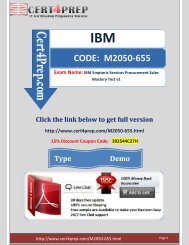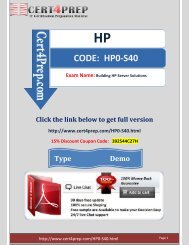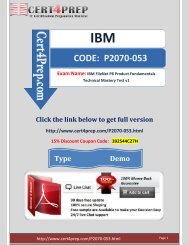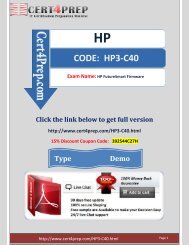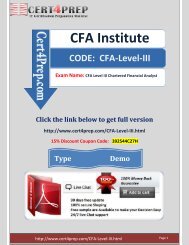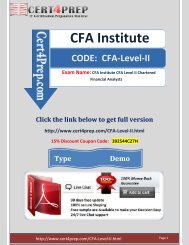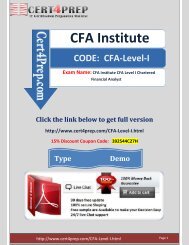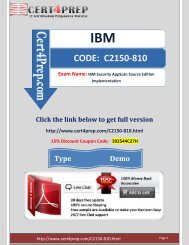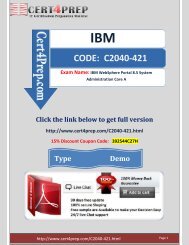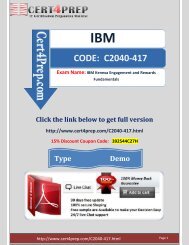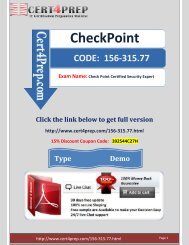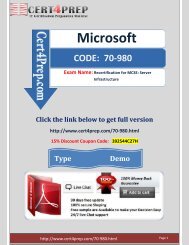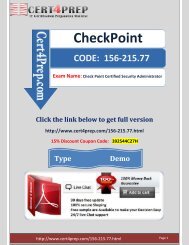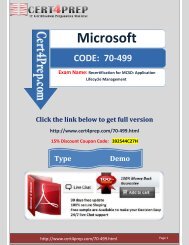1Z0-034 Free Demo Questions and Answers PDF.pdf
Cert4Prep is your ultimate source for exam questions and answers pdf type pdf questions and answers.
Cert4Prep is your ultimate source for exam questions and answers pdf type pdf questions and answers.
Create successful ePaper yourself
Turn your PDF publications into a flip-book with our unique Google optimized e-Paper software.
Oracle<br />
CODE: <strong>1Z0</strong>-<strong>034</strong><br />
Exam Name: Upgrade Oracle9i/10g OCA to Oracle<br />
Database 11g OCP<br />
Click the link below to get full version<br />
http://www.cert4prep.com/<strong>1Z0</strong>-<strong>034</strong>.html<br />
15% Discount Coupon Code: 392544C27H<br />
Type<br />
<strong>Demo</strong><br />
http://www.cert4prep.com/<strong>1Z0</strong>-<strong>034</strong>.html Page 1
Question: 1<br />
Which two statements are true about setting the FAST_ START_ MTTR_ TARGET initialization parameter<br />
to a nonzero value?<br />
A. The MTTR advisor will be disabled.<br />
B. Automatic checkpoint tuning will be enabled.<br />
C. The value for the LOG_CHECKPIONT_INTERVAL initialization parameter will be override the value for<br />
FAST_START_MTTR_TARGET.<br />
D. The time taken to recover the instance after the crash is always exactly the same as the value given<br />
for the FAST_START_MTTR_TARGET initialization parameter.<br />
Question: 2<br />
Answer: B,C<br />
You have set the value of the NLS_TIMESTAMP_TZ_FORMAT parameter to YYYY-MM-DD. The default<br />
format of which two data types would be affected by this setting?<br />
A. DATE<br />
B. TIMESTAMP<br />
C. INTERVAL YEAR TO MONTH<br />
D. INTERVAL DAY TO SECOND<br />
E. TIMESTAMP WITH LOCAL TIME ZONE<br />
Question: 3<br />
Answer: B,E<br />
Which two statements are true regarding the functionality of the remap comm<strong>and</strong> in ASMCMD?<br />
A. It repairs blocks that have read disk I/O errors.<br />
B. It checks whether the alias metadata directory <strong>and</strong> the file directory are linked correctly.<br />
C. It repairs blocks by always reading them from the mirror copy <strong>and</strong> writing them to the original<br />
location.<br />
D. It reads the blocks from a good copy of an ASM mirror <strong>and</strong> rewrites them to an alternate location on<br />
disk if the blocks on the original location cannot be read properly.<br />
http://www.cert4prep.com/<strong>1Z0</strong>-<strong>034</strong>.html Page 2
Answer: A,D<br />
Question: 4<br />
What happens when you run the SQL Tuning Advisor with limited scope?<br />
A. Access path analysis is not performed for SQL statements.<br />
B. SQL structure analysis is not performed for SQL statements.<br />
C. SQL Profile recommendations are not generated for SQL statements.<br />
D. Staleness <strong>and</strong> absence of statistics are not checked for the objects in the query supplied to the SQL<br />
Tuning Advisor.<br />
Question: 5<br />
Answer: C<br />
Which options would you consider while configuring a flash recovery area (fast recovery area in 11g<br />
Release 2) for your production database that is running in ARCHIEVELOG mode? (Choose all that apply.)<br />
(Choose all that apply.)<br />
A. setting the FAST_START_MTTR_TARGET to set the mean time to recover<br />
B. setting the RECOVERY_PARALLELISM parameter to twice the number of CPUs<br />
C. using the DB_RECOVERY_FILE_DEST parameter to set the location for flash recovery area<br />
D. using the DB_RECOVERY_FILE_DEST_SIZE parameter to define the disk space limit for the recovery<br />
files created in the flash recovery area.<br />
Question: 6<br />
Answer: C,D<br />
Examine the following RMAN comm<strong>and</strong>:<br />
RMAN> CONFIGURE ENCRYPTION FOR DATABASE ON; RMAN> BACKUP DATABASE PLUS ARCHIVELOG;<br />
Which perquisite must be met before accomplishing the backup?<br />
A. Provide a password for the encryption.<br />
B. Set up an Oracle wallet for the encryption.<br />
C. No setup is required as it is a default encryption method.<br />
D. Both Oracle wallet <strong>and</strong> password must be set up for the encryption.<br />
http://www.cert4prep.com/<strong>1Z0</strong>-<strong>034</strong>.html Page 3
Answer: B<br />
Explanation: http://download.oracle.com/docs/cd/B28359_01/backup.111/b28270/rcmconfa.htm<br />
To configure the environment so that all RMAN backups are encrypted:Set up the Oracle wallet as<br />
explained in Oracle Database Advanced Security Administrator’s Guide.<br />
Issue the following RMAN comm<strong>and</strong>:<br />
CONFIGURE ENCRYPTION FOR DATABASE ON;<br />
At this stage, all RMAN backup sets created by this database will use transparent encryption by default<br />
Question: 7<br />
Examine these Data Pump comm<strong>and</strong>s to import objects to non-existent users hr1 <strong>and</strong> oe1.<br />
S expdp system/manager<br />
Schemas =hr,oe<br />
directory =EXP_ DIR<br />
include = table<br />
$ impdp system/manager<br />
Schemas = hr1,oe1<br />
Directory = EXP_DIR<br />
Dumpfile = export.dat<br />
Remap_schema =hr:hr1,oe :oe1<br />
What would be achieved by running the above comm<strong>and</strong>s?<br />
A. expdp will fail because no path has been defined for the dumpfile.<br />
B. expdp will succeed but Impdp will fail because users do not exist.<br />
C. impdp will create two users called hrl <strong>and</strong> oe1 <strong>and</strong> import all objects to the new schemas<br />
D. impdp will create two users called hrl <strong>and</strong> oe1 <strong>and</strong> import tables owned by hr <strong>and</strong> oe schemas to hr1<br />
<strong>and</strong> oe1 schemas, respectively.<br />
Question: 8<br />
Answer: B<br />
The database is configured in ARCHIEVELOG mode <strong>and</strong> regular complete database backups are taken.<br />
The loss of which two types of files may require a recovery with the RESETLOGS option?<br />
A. Control files<br />
B. Password file<br />
C. Inactive online redo log file<br />
D. Archived log files required to perform recovery<br />
E. Newly created tablespace which is not backed up<br />
http://www.cert4prep.com/<strong>1Z0</strong>-<strong>034</strong>.html Page 4
Answer: A,D<br />
Explanation:<br />
The RESETLOGS options is required in:<br />
1. Imcomplete Recovery<br />
2. Change of control file<br />
So that, the control file <strong>and</strong> archived redo logs are required.<br />
Question: 9<br />
User SCOTT wants to back out the transactions on the REGIONS table in his schema. As a DBA, which<br />
comm<strong>and</strong>s must you execute to enable SCOTT to flash back the transactions?<br />
A. ALTER DATABASE FLASHBACK ON;<br />
B. GRANT SELECT ANY TRANSACTION TO scott;<br />
C. GRANT EXECUTE ON dbms_flashback TO scott;<br />
D. ALTER DATABASE ADD SUPPLEMENTAL LOG DATA;<br />
E. ALTER TABLESPACE undots1 RETENTION GUARANTEE;<br />
F. ALTER DATABASE ADD SUPPLEMENTAL LOG DATA (PRIMARY KEY) COLUMNS;<br />
Question: 10<br />
Answer: B,C,D,F<br />
The DB_BLOCK_CHECKING parameter is set to FULL.<br />
What checks occur each time the DBWnprocess(es) writes?<br />
A. The Oracle database will check all data blocks by going through the data on each block, making sure<br />
the data is self-consistent.<br />
B. The DBWn <strong>and</strong> the direct loader will calculate a checksum <strong>and</strong> store it in the cache header of every<br />
data block when writing it to disk.<br />
C. The Oracle database will check data blocks belonging to the SYSTEM tablespace only, by going<br />
through the data on each block, making sure the data is self-consistent.<br />
D. The Oracle database will check data blocks belonging to the SYSAUX tablespace only, by going<br />
through the data on each block, making sure the data is self-consistent.<br />
E. The Oracle database will check data blocks in the SYSTEM <strong>and</strong> SYSAUX tablespaces only, by going<br />
through the data on each block, making sure the data is self-consistent.<br />
Answer: A<br />
http://www.cert4prep.com/<strong>1Z0</strong>-<strong>034</strong>.html Page 5
Question: 11<br />
You are managing a 24*7 database. The backup strategy for the database is to perform<br />
usermanagedbackups. Identify two prerequisites to perform the backups. (Choose two.)<br />
A. The database must be opened in restricted mode.<br />
B. The database must be configured to run in ARCHIVELOG mode.<br />
C. The tablespaces are required to be in backup mode before taking the backup.<br />
D. The tablespaces are required to be in read-only mode before taking the backup<br />
Question: 12<br />
Answer: B,C<br />
You need to configure fine-grained access control to external network resources from within your<br />
database. You create an access control list (ACL) using the DBMS_NETWORK_ACL_ADMIN package.<br />
Which statement is true regarding the ACL created?<br />
A. It is a list of remote database links stored in the XML file that are available to the users of the<br />
database.<br />
B. It is a list of users <strong>and</strong> network privileges stored in the XML file according to which a group of users<br />
canconnect to one or more hosts.<br />
C. It is a list of users <strong>and</strong> network privileges stored in the data dictionary according to which a group of<br />
userscan connect to one or more hosts.<br />
D. It is the list of the host names or the IP addresses stored in the data dictionary that can connect to<br />
yourdatabase through PL/SQL network utility packages such as UTL_TCP.<br />
Answer: B<br />
Explanation:<br />
The DBMS_NETWORK_ACL_ADMIN package provides the interface to administer the network Access<br />
ControlList (ACL).<br />
Refer to here for About Fin-Grained Access to External Network ServicesConfiguring fine-grained access<br />
control for users <strong>and</strong> roles that need to access external network services fromthe database. This way,<br />
specific groups of users can connect to one or more host computers, based onprivileges that you grant<br />
them. Typically, you use this feature to control access to applications that run onspecific host addresses.<br />
To configure fine-grained access control to external network services, you create an access control list<br />
(ACL),which is stored in Oracle XML DB. You can create the access control list by using Oracle XML DB<br />
itself, orby using the DBMS_NETWORK_ACL_ADMIN <strong>and</strong> DBMS_NETWORK_ACL_UTILITY PL/SQL<br />
packages. This guideexplains how to use these packages to create <strong>and</strong> manage the access control list. To<br />
create an access controllist by using Oracle XML DB <strong>and</strong> for general conceptual information about access<br />
control lists, see Oracle XMLDB Developer's Guide.<br />
http://www.cert4prep.com/<strong>1Z0</strong>-<strong>034</strong>.html Page 6
Question: 13<br />
View the Exhibit <strong>and</strong> examine the RMAN comm<strong>and</strong>s.<br />
Which statement describes the effect of a backup retention policy on the backup of a backup set?<br />
A. Either all the copies of a backup set are obsolete or none of them are as per the retention policy.<br />
B. The copies of the backup will be reported as obsolete under a redundancy-based backup retention<br />
policy.<br />
C. The copies of the backup will be reported as obsolete under a recovery window-based backup<br />
retentionpolicy.<br />
D. All the copies of the backup set are counted as one instance of a backup <strong>and</strong> will deleted in backup<br />
setexceeds the redundancy-based backup retention policy.<br />
Question: 14<br />
Answer: A<br />
Which four resources can directives be specified by using the Oracle Resource Manager?<br />
A. CPU usage<br />
B. degree of parallelism<br />
http://www.cert4prep.com/<strong>1Z0</strong>-<strong>034</strong>.html Page 7
C. number of open cursors<br />
D. number of sorts performed<br />
E. idle time for blocking sessions<br />
F. number of I/Os requests<br />
Answer: A,B,E,F<br />
Question: 15<br />
You are using the control file to maintain information about the database backups that are being<br />
performed by Recovery Manager (RMAN). Identify two scenarios in which you must have a recovery<br />
catalog.<br />
A. To store the backup information of multiple database<br />
B. To restrict the amount of space that is used by the backups<br />
C. To maintain a backup for a certain time is set by the CONTROL_FILE_RECORD_KEEP_TIME parameter.<br />
D. To list the data files that were in a target database at a given time by using the AT option of<br />
REPORTSCHEMA comm<strong>and</strong>.<br />
Answer: A,D<br />
http://www.cert4prep.com/<strong>1Z0</strong>-<strong>034</strong>.html Page 8
Oracle<br />
CODE: <strong>1Z0</strong>-<strong>034</strong><br />
Exam Name: Upgrade Oracle9i/10g OCA to Oracle<br />
Database 11g OCP<br />
Click the link below to get full version<br />
http://www.cert4prep.com/<strong>1Z0</strong>-<strong>034</strong>.html<br />
15% Discount Coupon Code: 392544C27H<br />
http://www.cert4prep.com/<strong>1Z0</strong>-<strong>034</strong>.html Page 9



